Egyptian Navy
| Egyptian Navy | |
|---|---|
| القوات البحرية المصرية | |
|
Naval Ensign | |
| Active | 1800 - Present (217 years) |
| Country | Egypt |
| Branch |
Egyptian Coast Guard Egyptian Navy Thunderbolt Egyptian Naval Aviation |
| Type | Navy |
| Size |
18,500 active (As of 2014)[1] 14,000 Reserve (As of 2014)[1] 32,500 Total (As of 2014)[1] 245 vessels (As of 2014)[2] |
| Part of |
|
| Headquarters | Alexandria |
| Colours |
Blue, Red, White and Black |
| Anniversaries | 21 October |
| Equipment | Current Fleet |
| Commanders | |
| Commander in Chief of the Navy | Vice Admiral Ahmed Khaled Hassan Saeed |
| Chief of Staff of the Navy | Rear Admiral Mohamed Abdel Aziz El Sayed |
| Insignia | |
| Ceremonial Flag |
 |
| Insignia | Egyptian Navy ranks |
| Aircraft flown | |
| Attack | Rafale, F-16 |
| Electronic warfare | Northrop Grumman E-2 Hawkeye |
| Fighter | Rafale, F-16 |
| Helicopter | Aérospatiale Gazelle, Kaman SH-2G Super Seasprite, Westland Sea King, NH90 |
The Egyptian Navy is the maritime branch of the Egyptian Armed Forces. It is the largest navy in the Middle East and Africa, and is the sixth largest in the world measured by the number of vessels.[3] The navy's missions include protection of more than 2,000 kilometers of coastline of the Mediterranean Sea and the Red Sea, defense of approaches to the Suez Canal, and support for army operations. The majority of the Egyptian Navy was created with the help of the Soviet Union in the 1960s. The navy received ships in the 1980s from China and other, western, sources. In 1989, the Egyptian Navy had 18,000 personnel as well as 2,000 personnel in the Coast Guard.[4]
History
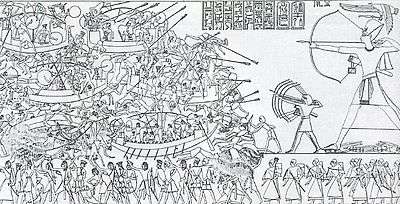

Egypt has had a navy since Ancient Egyptian times. The Ancient Egyptian Navy was a vital part of the military of ancient Egypt, helping to transport troops along the Nile River and fighting many battles such as the Battle of the Delta against the Sea Peoples. The Ancient Egyptian Navy imported many of their ships from countries such as the Kingdom of Cyprus.[5] Several Ancient Egyptian solar ships are still present today.
In the early 1800s, Egypt under Muhammad Ali Pasha developed a modern European-style army and navy. After intervening in the Greek War of Independence at Ottoman Turkey's request, the Egyptian navy was destroyed in 1827 at the Battle of Navarino by the fleets of Great Britain, France and Russia. With the Egyptian army in Greece then isolated, Muhammad Ali made terms with the British and withdrew a year later.
A replacement fleet was built for the First Egyptian-Ottoman War in 1831, and landed troops at Jaffa in support of the main Egyptian army marching into Syria. In the Second Egyptian–Ottoman War in 1839, following Egyptian victory in the Battle of Nezib, the Ottoman fleet sailed to Alexandria and defected to the Egyptian side. However, these victories provoked decisive European intervention to support the Turks, and while Muhammad Ali's dynasty continued to reign, Egypt ended up effectively a British colony until the 1950s.
The Egyptian navy was only peripherally involved in the series of conflicts with Israel. On 22 October 1948, the Egyptian sloop El Amir Farouq was sunk in the Mediterranean Sea off Gaza by a motor explosive boat of the Israeli Navy during the Israeli naval campaign in Operation Yoav as part of the 1948 Arab-Israeli War.[6][7][8] During the Suez Crisis, Egypt dispatched the Ibrahim el Awal, an ex-British Hunt class destroyer, to Haifa with the aim of shelling that city's coastal oil installations. On 31 October the Ibrahim el Awal reached Haifa and began bombarding the city but was driven off by a French warship and then pursued by the Israeli destroyers INS Eilat and INS Yaffo which, with the help of the Israeli Air Force, captured the ship.[9] Egyptian destroyers and torpedo boats engaged larger British vessels in a move aimed at undermining the amphibious operations of the British and French. On the night of 31 October in the northern Red Sea, the British light cruiser HMS Newfoundland challenged and engaged the Egyptian frigate Domiat, reducing it to a burning hulk in a brief gun battle. The Egyptian warship was then sunk by escorting destroyer HMS Diana, with 69 surviving Egyptian sailors rescued.[10]

The Egyptian Navy's blockade of Israeli ships in the Strait of Tiran that were headed toward the Israeli port of Eilat was one of the main causes of the Six-Day War. During the war, the Israeli Navy landed six combat divers from the Shayetet 13 naval commando unit to infiltrate Alexandria harbor. The divers sank an Egyptian minesweeper before being taken prisoner. Both Egyptian and Israeli warships made movements at sea to intimidate the other side throughout the war, but did not engage each other. However, Israeli warships and aircraft did hunt for Egyptian submarines throughout the war.
In October 1967, a few months after the cease-fire, the Egyptian Navy was the first navy in history to sink a ship using anti-ship missiles, when an Egyptian Komar-class fast-attack craft sank the Israeli destroyer INS Eilat with two direct hits.[11] This was a milestone of modern naval warfare, and for the first time anti-ship missiles showed their potential, sinking the destroyer 17 km off Port Said.
On the night of 15–16 November 1969, Egyptian Navy frogmen attacked the port of Eilat and caused severe damages to the armed transport ship Bat Yam.[12] On 5–6 February 1970, the frogmen attacked the Israeli landing ships at the same port and same piers causing severe damages to the landing ship Bait Shivaa and transport armed ship Hydroma.[12] On 8 March 1970, the frogmen attacked the Israeli oil drill Keting at the port of Abidjan in Ivory Coast believing that Israel had bought this oil drill from the Netherlands for the purposes of oil exploration in the Suez Gulf.[12]
In the Yom Kippur War, Egypt blocked commercial traffic to Eilat in the Gulf of Aqaba by laying mines; it also attempted to blockade Israeli ports on the Mediterranean.[4] The navy also used the coastal artillery to the east of Port Fouad to support the Egyptian Army in order to prepare for the assault on the Suez Canal.[12] In the Battle of Baltim, three Egyptian Osa-class missile boats were sunk.
Chain of command
| officers | ||||||||||||||
|---|---|---|---|---|---|---|---|---|---|---|---|---|---|---|
| Admirals | Senior officers | Junior officers | ||||||||||||
| Shoulder straps | |
|
|
|
|
|
|
|
|
| ||||
| Patches |  |
 |
 |
 |
 |
 |
 |
 |
 |
 | ||||
| Title | Admiral فريق أول |
Vice Admiral فريق |
Rear Admiral لواء |
Commodore عميد |
Captain عقيد |
Commander مقدم |
Lieutenant Commander رائد |
Lieutenant نقيب |
Sub-lieutenant ملازم أول |
Ensign ملازم | ||||
| NATO code | OF-9 | OF-8 | OF-7 | OF-6 | OF-5 | OF-4 | OF-3 | OF-2 | OF-1 | |||||
| Under the officers and sailors | ||||||
|---|---|---|---|---|---|---|
| Patches |  |
|
|
— | ||
| Title | Chief Petty Officer رقيب أول |
Petty Officer رقيب |
Leading Seaman عريف |
Seaman جندي | ||
| NATO code | OR-4 | OR-3 | OR-2 | OR-1 | ||
Flags
| Flag | Ceremonial Flag | Pennant |
|---|---|---|
 |
 |
|
Ranks Flags
| Vice-admiral | Rear-admiral | Senior on the roads |
|---|---|---|
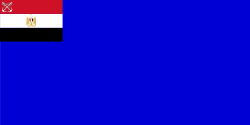 |
 |
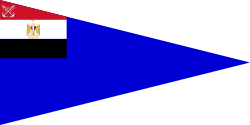 |
Bases
Mediterranean
The Egyptian navy's headquarters and main base is at Alexandria on the Mediterranean Sea with other Mediterranean naval bases at Port Said and Mersa Matruh.
Red Sea
Egypt naval bases on the Red Sea are Hurghada, Safaga, Berenice and Suez.
Present fleet
The Egyptian Navy will be restructured into two different fleets, one for the Mediterranean sea and the other for the Red Sea. This in a context where the safety of shipping in the Red Sea is becoming increasingly important.[13]
Ships
|
Aircraft
The navy lacked its own air arm and depended on the air force for maritime reconnaissance and protection against submarines. The air force's equipment that supported the navy included twelve Gazelle and five Sea King helicopters mounted with antiship and antisubmarine missiles. In mid-1988 the air force also took delivery of the first of six Grumman E-2c Hawkeye aircraft with search and side-looking radar for maritime surveillance purposes.
The Egyptian Air Force equipment that supports the navy includes the following:
- 9 Aérospatiale Gazelle, used for naval shore reconnaissance.
- 10 Kaman SH-2G Super Seasprite (with 3 additional used as spares), armed with Anti submarine torpedoes.
- 5 Westland Sea King helicopters mounted with antiship missiles and antisubmarine torpedoes.
In mid-1988 the air force also took delivery of the first of 6 Grumman E-2C Hawkeye aircraft, now 8 units are operational and are used to secure the maritime borders among other missions; it also operates 6 Beechcraft 1900C aircraft for maritime surveillance purposes with search and side-looking radar. The Egyptian Navy also uses Mil Mi-8 and Sea King helicopters to transport troops.[14] also Russia confirmed the sale of 46 Ka-52Ks to Egypt in December 2015. Russian Helicopters Director-General Alexander Mikheyev said deliveries to Egypt are expected to occur in 2017.[15]
|
Submarine fleet
Egypt is in the process of acquiring four German 209 class SSKs. There is no hard evidence that the Egyptian submarine fleet is capable of operating swimmers; indeed, the four submarines have not been reported at sea for some time. Nevertheless, the navy does possess a UDT team and SDVs.
|
Amphibious fleet
The first Mistral helicopter carrier named after late President Gamal Abdel-Nasser arrived in Alexandria in June 2016. On September 16, 2016, the Egyptian Navy Commander, Admiral Osama Rabie, raised the Egyptian flag on board of the BPC-210 Mistral Class amphibious assault ship (BPC/LHD).[16] Russia and Egypt had signed a deal for Egypt’s purchase of 50 Ka-52 Alligator attack helicopters from Russia. The purchase includes the variant of the Ka-52 Katran, which specifically designed for the Mistrals that Russia had intended to acquire.[17]
|
Surface fleet
Only those escorts capable of operating troop-lift helicopters (Kaman SH-2G Seasprite) are shown. It must, though, be accepted that all surface ships can launch and recover the rubber assault craft known to be used by the army's commando groups. Additionally the two, 1,702 ton Jianghu I class FFGs and the two, 1,479 ton Descubierta class FFGs can supply naval gunfire support.
Patrol forces
The Egyptian Navy has a potent fleet of fast attack craft, many fitted with missile systems. These and the navy-manned vessels of the Coast Guard, would be deployed in support of amphibious landings and certainly in their prevention.
Equipment
Ship to ship/surface missiles
- P-270 Moskit/SS-N-22 with 120 km range and 320 kg payload (launched from P-32 Molniya-class missile boat).
- HY-1 with 85 km range and 513 kg payload (launched from Hegu-class Coastal FAC/M).
- Harpoon with more than 124 km range and 220 kg payload (launched from Ambassador-class FPB/M, Knox-class frigates, Oliver Hazard Perry-class frigates and Descubierta-class light frigates).
- Exocet (MM-38) with 65 km range and 165 kg payload (launched from Tiger-class FPB/M).
- Otomat Mk1 with 80 km range and 210 kg payload (launched from Ramadan-class FPB/M & October-class FAC/M).
- SS-N-2a Styx with 43 km range and 513 kg payload (launched from OSA I).
Surface to ship/surface missile (coastal defence)
- FL-1 with 150 km range and 513 kg payload.
- KSR-2 (AS-5 "Kelt") with 200 km range and 1000 kg payload. (Modified from air-launched version)
- Otomat MkII with 180 km+ range and 210 kg payload.
- Exocet (MM-40 MK III) with 180 km range and 165 kg payload.
The Egyptian Coast Guard
| Part of a series on |
| Armed Forces of the Arab Republic of Egypt |
|---|
| Administration |
| Service branches |
| Armies and Military Areas |
| Special Forces |
| Ranks of the Egyptian Military |
| History of the Egyptian military |
The Egyptian Coast Guard is responsible for the onshore protection of public installations near the coast and the patrol of coastal waters to prevent smuggling. Currently consists of one hundred five ships and craft.
Patrol boats
- 22 Timsah I/II class
- 12 Sea Spectre PB Mk III class
- 9 Swiftships class
- 6 MV70 class
- 5 P-6 (Project 183) class
- 3 Textron class
Patrol crafts
- 25 Swiftships 26m class
- 16 SR.N6 class
- 9 Type 83 class
- 6 Crestitalia class
- 12 Spectre class
- 12 Peterson class
- 5 Nisr class
- 29 DC-30 class
- 3 of 6 MRTP-20 Yonka Onuk MRTP-20 class[18][19][20]
Future
The Egyptian Navy has adopted the 60m diesel-powered Ambassador MK III fast missile patrol craft. The construction of the boats began in spring 2001. Egypt already had an older version of the Ambassador patrol craft in service, but the new boats would contain an update in design meant to make the vessels more resistant to radar detection. Design was conducted with the assistance of Lockheed Martin. Throughout recent years, Egypt has been constructing various Ramos-grade shipyards, which are capable of making more recent vessels like larger fast attack crafts, low-grade aircraft carriers (such as Oryx-class or Nimitz-class) and nuclear submarines, though none of the aforementioned vessles have been constructed there.
The navy is currently undergoing a modernization of its surface fleet. On 16 February 2015, the Egyptian Navy ordered one FREMM multipurpose frigate from the French shipbuilder DCNS to enter service before the opening of the New Suez Canal, as part of a larger deal (including 24 Rafales and a supply of missiles) worth €5.2bn.[21][22] Egypt has also signed a €1bn contract with DCNS to buy four Gowind 2,500 ton corvettes with an option for two more.[23] The ageing submarine fleet is to be replaced starting in 2016 when the first of four Type 209 submarine's worth €920 million start arriving from Germany.[24]
On 7 August 2015, Le Monde reported that Egypt and Saudi Arabia are in discussions with France to purchase the two amphibious assault ship Mistral class originally intended for Russia. Le Monde quoted a French diplomatic source as confirming that French President François Hollande discussed the matter with Egyptian President Abdel Fattah el-Sisi during his visit to Egypt during the inauguration of the New Suez Canal in Ismailia.[25][26] On 24 September 2015, the French presidency announced that an agreement had been reached with Egypt for the supply of the two Mistrals.[27][28]
Commanders

- Admiral Mahmoud Hamza Pasha (6 June 1946 – 1 October 1948)
- Admiral Ahmed Bek Badr (2 October 1948 – 30 September 1951)
- Admiral Mahmoud Bek Badr (1 October 1951 – 27 July 1952)
- Vice Admiral Mohamed Nashid (28 July 1952 – 14 September 1952)
- Admiral Suleiman Ezzat (15 September 1952 – 10 June 1967)
- Vice Admiral Fouad Abu Zikry (11 June 1967 – 11 September 1969)
- Rear Admiral Mahmoud Abdel Rahman Fahmy (12 September 1969 – 24 October 1972)
- Vice Admiral Fouad Abu Zikry
- Vice Admiral Ashraf Refaat
- Vice Admiral Mohamed Ali Mohamed
- Vice Admiral Ali Tawfik Gad (April 1983 - Oct 1987)
- Vice Admiral Sherif AlSadek (Oct 1987 - Oct 1990)
- Vice Admiral Ahmed Fadel
- Vice Admiral Ahmed Saber Seleem
- Vice Admiral Tamer Abdel Alim (October 2005 - October 2007)
- Vice Admiral Mohab Mamish (October 2007 - 11 August 2012)
- Vice Admiral Osama Ahmed ElGendy (14 August 2012 - 12 April 2015 )
- Vice Admiral Osama Mounir Rabie (13 April 2015 - 16 December 2016)
- Vice Admiral Ahmed Khaled Hassan Saeed (17 December 2016 - present)
See also
| Wikimedia Commons has media related to Navy of Egypt. |
- Ancient Egyptian navy
- Battle of Navarino included the Egyptian Navy
- Egyptian Armed Forces
- List of ships of the Egyptian Navy
References
- 1 2 3 International Institute for Strategic Studies (3 Feb 2014). The Military Balance 2014. London: Routledge. pp. 315–318. ISBN 9781857437225.
- ↑ "Total Navy Ship Strength by Country".
- ↑ Global Firepower. "Navy Ship Strength by Country".
- 1 2 "Egyptian Navy".
- ↑ Kostas (2001)
- ↑ "El Amir Farouq sloop (1926) - Egyptian Navy (Egypt)". navypedia. Retrieved 27 November 2015.
- ↑ "El Amir Farouq 1926". TyneBuiltShips. Retrieved 27 November 2015.
- ↑ Wandres, J., "Ben-Gurion's Bathtub Corps," Military History, March 2016, p. 67.
- ↑ Max Wurmbrand, The Valiant of Israel, p. 80, Massada Press Ltd (1967)
- ↑ Pimlott – editor British Military Operations, 1945–1984 London: Guild Publishing 1984 p. 78
- ↑ Saad El Shazly The Crossing of the Suez p. 23
- 1 2 3 4 http://www.mmc.gov.eg/branches/Navy/t4.htm
- ↑ "Egypte : après la FREMM...". ttu.fr (in French). 26 June 2015.
- ↑ "Egyptian military aviation OrBat".
- ↑ http://www.defenceweb.co.za/index.php?option=com_content&view=article&id=46664:russia-ready-to-deliver-first-egyptian-ka-52s&catid=124:military-helicopters
- ↑ http://www.israeldefense.co.il/en/content/egyptian-navy-stronger-ever
- ↑ http://www.defenceweb.co.za/index.php?option=com_content&view=article&id=46664:russia-ready-to-deliver-first-egyptian-ka-52s&catid=124:military-helicopters
- ↑ http://www.yonca-onuk.com/productList.php/?p=79
- ↑ "قائد القوات البحرية: أحدث لنشات الصواريخ تنضم للخدمة 2013.. وبناء غواصتين من الجيل المتقدم بألمانيا - بوابة الأهرام". Retrieved 2014-06-05.
- ↑ "First Turkish Interceptor Delivered To Egyptian Navy |". Retrieved 2014-06-05.
- ↑ Lert, Frédéric (16 February 2015). "Egypt officially signs for 24 Rafales, FREMM frigate, and missiles". IHS Jane's Defence Weekly. Retrieved 21 February 2015.
- ↑ "Official French Navy Statement on the Sale of a FREMM Multi-Mission Frigate to Egypt". 13 February 2015.
- ↑ "Egyptian Navy would be about to order 4 to 6 Gowind Combat Corvettes from DCNS". navyrecognition.com. 5 March 2014. Retrieved 26 September 2014.
- ↑ Binnie, Jeremy (3 February 2014). "Egypt reportedly to exercise option for two more subs". IHS Jane's 360. Retrieved 3 September 2014.
- ↑ "Mistral : l’Arabie saoudite et l’Egypte « sont prêtes à tout pour acheter les deux navires »". Le Monde.fr.
- ↑ "france 24 - Egypt, Saudi Arabia ‘desperate’ to purchase Mistral warships - France 24". France 24.
- ↑ "Vente BPC". Elysee. 23 September 2015. Retrieved 24 September 2015.
- ↑ "Egypt agrees to buy warships built for Russia from France". BBC News. 23 September 2015. Retrieved 24 September 2015.

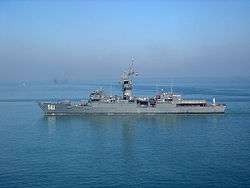

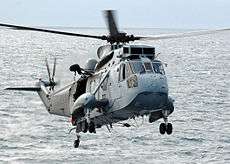


_submarine_escape_and_rescue_exercise_Sorbet_Royal_2005.jpg)

_pulls_into_the_well_deck_of_the_amphibious_assault_ship_USS_WASP_(LHD_1).jpg)

_14%2C_assigned_to_Assault_Craft_Unit_(ACU)_2%2C_transports_Sailors%2C_Soldiers_and_Marines_during_operations_supporting_Joint_Logistics_Over-The-Shore_(JLOTS)_exercises.jpg)